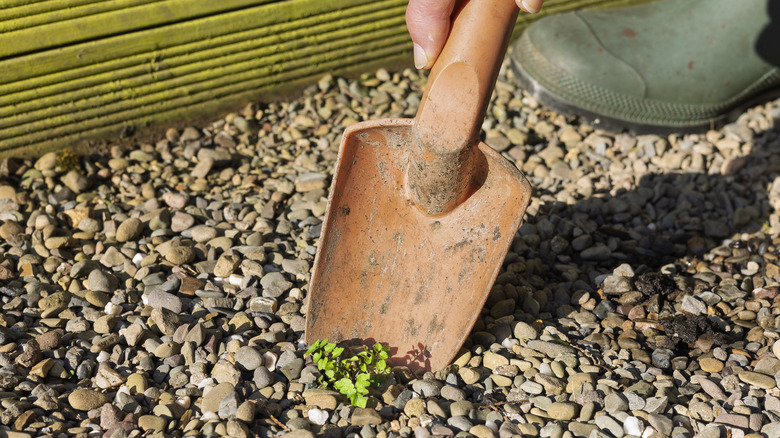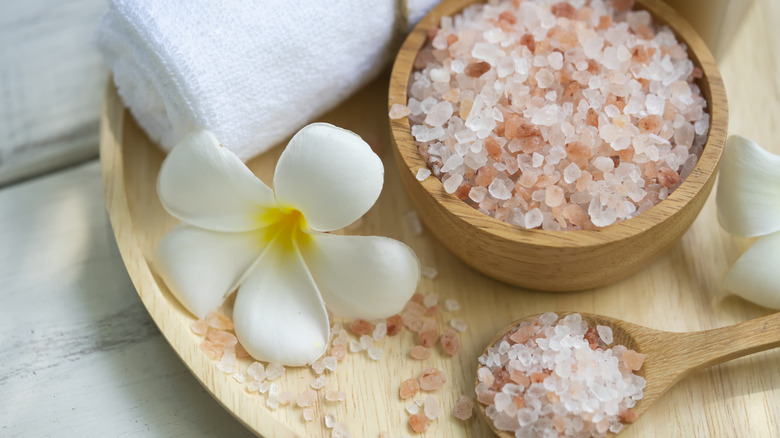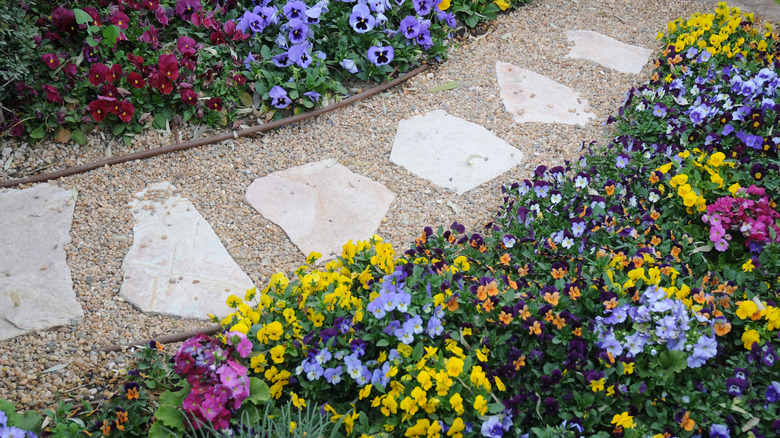The Surefire Way To Get Weeds Out Of Gravel For Good
We may receive a commission on purchases made from links.
When you think about all the ways you can use gravel in your yard to create stunning landscapes, what's the one thing that can ruin it all? Weeds! These invaders are persistent, hard to get rid of, and can ruin the visual appeal of your carefully cultivated garden. While the go-to solution to get rid of weeds is to grab a chemical weed killer and get spraying, rock salt is a natural alternative that is highly effective.
While it seems too good to be true, this common household item works by drawing moisture from the weeds and disrupting the internal water processes they need to survive. We all know that if you're lost at sea and thirsty, the seawater won't help but will harm you because of the high salt content. The same principle applies to weeds. Salt dehydrates them, desiccating their internal structure and causing the plant to die.
Rock salt, such as Pro-Cure Bulk Rock Salt, is cheaper than expensive chemicals and easy to get your hands on. Salt begins working the moment it's applied, though you might only begin to see visible signs of it working 24 to 48 hours after that. Over the next two weeks, you'll notice most of the weeds should be dead or dying. Salt is a great solution for gravel, particularly if you don't intend on growing anything nearby anytime soon. High levels of salinity can cause runoff into the surrounding soil structure and affect the growth of all plant life.
How to use rock salt to kill weeds growing in your gravel
Salt is used to flavor food, increase the effectiveness of some beauty treatments, and clear driveways of ice and snow. Of all the genius ways to use salt around the house, killing weeds is the simplest. The most basic method involves placing a few salt crystals around the base of the weeds you'd like to be rid of. Keep in mind that a little goes a long way. Using crystals in this way allows you to target specific weeds directly.
For treating long pathways, dissolve the salt in water, as using a salty solution makes widespread distribution easier. You'll need approximately 1 cup of salt per 1 gallon of hot water. Using hot liquid is helpful because it speeds up the dissolving process. Once all the salt is dissolved, pour the solution into a watering can with a fine spout, such as the Qilebi Watering Can for Outdoor Plants, as this helps with careful aiming. You can also use a spray bottle, preferably one with an adjustable spray width set to narrow.
Large expanses of gravel can benefit from a thin layer of salt being sprinkled evenly over the entire area. Using rock salt allows the salt to dissolve slowly over time and keeps it working actively over longer periods. To get an even spread of salt, consider using a Scotts Elite Spreader, though sprinkling by hand does the job. Wear gloves if the salt irritates your skin.
Reasons to be cautious when using rock salt as a weed killer
While salt is a great weed killer, there are reasons to be cautious about how it's applied. Keep in mind that it's not selective and will kill any plant it comes into contact with. While chemical weedkillers are created to target specific species, salt doesn't discriminate. Another fact to consider is that salt will seep into the ground and prevent anything from growing for a long time, as it changes the soil, sterilizing it and removing all the elements that support plant growth.
To minimize the effects of the runoff, wait for sunny, dry weather with no rain on the horizon to keep the salt crystals or salty solution close to the weeds. Rain tends to wash the salt into the soil and spread it, diluting the concentration and minimizing its effect on the weeds. One way to prevent the salty weed solution from affecting your flowers is to create a barrier between the gravel and plants using Waenlir Heavy Duty Weed Barrier Landscape Fabric or Anleolife Plastic Garden Landscape Edging.
After salting your gravel, water the surrounding beds and plants thoroughly to wash away or dilute any saltiness that may have reached them. If you want to make sure they're not in danger, here's what you need to measure the pH of your soil. Keep an eye on the pH levels, and chat with your local garden center to correct any imbalances to keep your plants thriving.


